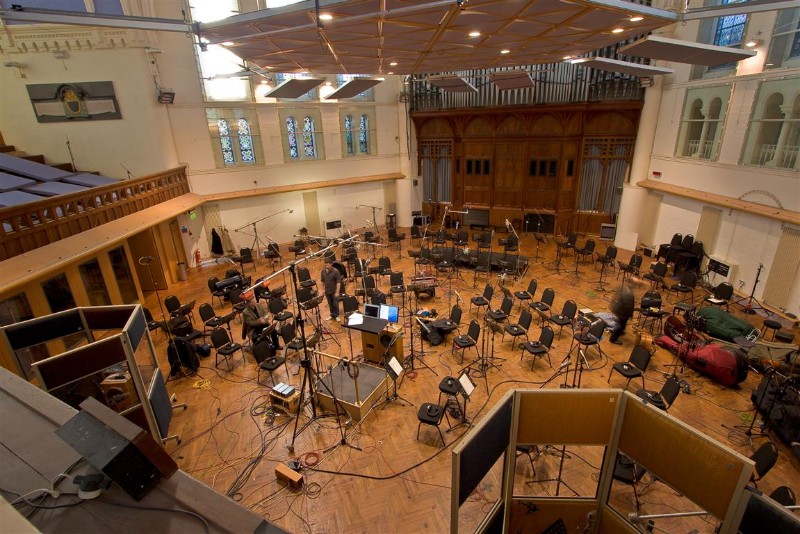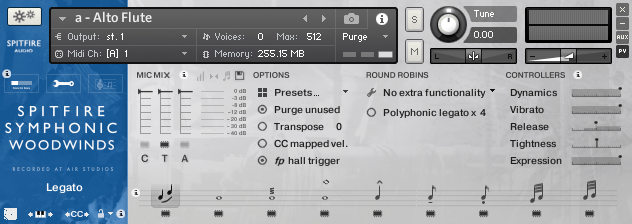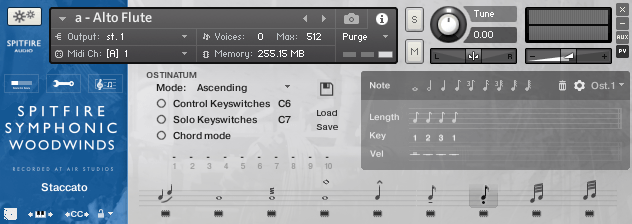Spitfire Audio just recently released another huge orchestral sample library – Symphonic Woodwinds – which marks the company’s conclusion of a year full of renovation and rationalization. After condensing their multitude of single string and brass libraries into curated compendiums with a modern concept, Spitfire Audio dealt the same with their renowned BML (British Modular Library) woodwind libraries.
I got myself a copy of Symphonic Woodwinds and today we’re taking a look at this hot contender for the most comprehensive orchestral woodwind library to date. Let’s find out how it performs both in terms of sound and use.
OVERVIEW
Symphonic Woodwinds consists of the following five woodwind libraries from Spitfire Audio’s BML range:
- BML Flute Consort
- BML Additional Flutes
- BML Reeds
- BML Low Reeds
- BML Low Winds
The sum of those libraries includes every traditional orchestral woodwind like flutes, oboes and clarinets, but also offers a variety of more unusual and modern instruments like bass flutes, contrabass clarinets and rumbling contrabassoons. Most instruments are offered in both solo and ensemble versions.
Symphonic Woodwinds is composed of over 72,500 samples and has a total size of nearly 72 GB – quite a mammoth of a library! It comes as a downloadable, NKS-ready Kontakt library.
All of the original instrument patches and articulations were re-programmed into Spitfire’s new and intuitive GUI which comes with an excellent inline help feature. In addition to the huge amount of original articulations, Spitfire Audio included a host of brand-new articulations that have never been released before.
Like most other libraries from Spitfire Audio, the samples used in Symphonic Woodwinds were recorded with handpicked, world-class performers at London’s iconic AIR Lyndhurst Hall. Initially recorded in four different microphone positions, for Symphonic Woodwinds, Spitfire Audio decided to go with ‘only’ three mic options, cutting away the Outriggers. All of the deep-sampled articulations feature various round-robins as well as multiple dynamic layers, to render MIDI performances as authentic as possible.

Every instrument is recorded and positioned in situ (at its place in the orchestra), which not only eliminates any panning guesswork, but also makes for a very homogenous and realistic soundscape when combining different instruments.
SYMPHONIC WOODWINDS IN USE
One thing that’s apparent when loading up Symphonic Woodwinds in the Kontakt Player, is the enormous number of different patches and articulation available. Apart from using pre-configured multi patches including the most essential playing styles of a given instrument, you can also access all the individual articulations for any instrument separately. This helps a lot with keeping a low CPU footprint if you only need certain playing styles in your project.
The long articulations of Spitfire’s woodwind orchestra all have a certain kind of liveliness and expression to them which can even be enhanced by using the interface’s modulation controls.
Another thing I particularly loved was the selection of different short articulations you’re provided with for every instrument. These enable you to perform both snappy ostinati and chordal patterns as well as broad and noble marcato passages.
Spitfire Audio – Symphonic Woodwinds In Action
Legatos
Since for the most part, the Legato articulations are what separates the wheat from the chaff, this is where I started when trying out Symphonic Woodwinds for the first time. And what can I say – the Legatos sound marvellous. The transitions between note intervals are pleasantly pronounced but not a bit intrusive. Especially the flutes and clarinets offer a beautiful legato sound that instantly reminds you of melody lines from masterpiece soundtracks of John Williams and Howard Shore.
One thing, I was a bit disappointed by, was the lack of so-called Performance Legato articulations. Those playing styles were made available for all the other recently revamped collections like Symphonic Brass or Symphonic Strings but are sadly missing here. With the Performance Legato articulations, you can play both slurred legato passages and accentuated staccato lines just by altering your velocity and playing speed. This smartly programmed playing method would have been hugely valuable to have in Symphonic Woodwinds in order to easily perform realistic and easy-to-play melody lines.
I really hope that those Performance Legato articulations will be added in a future update, since they would add a profound amount of value to the whole library.
THE SOUND OF SYMPHONIC WOODWINDS
The overall sound of Symphonic Woodwinds’ samples is very pristine and for the most part clear from flaws. The occasional little noises and tiny intonation quirks don’t really bother, but in fact make for a more authentic and natural playing sensation in my opinion.
Most of the patches also let you seamlessly blend between a non-vibrato and an expressive vibrato playing style. This makes it possible to program woodwind accompaniments that start out unobtrusively in the back and eventually build up to a vivid, passionate performance.
Spitfire Audio – Symphonic Woodwinds Audio Demos
Click on the button to load the content from soundcloud.com.
The whole palette of woodwind instruments and sounds gets across authentically and powerful. Of course, every instrument has its sweet spots in terms of their key range, but even if you exceed these naturally set limits, Spitfire Audio managed to keep up a convincing and usable sound.
AIR Lyndhurst’s beautiful hall sound that is baked in the samples, bathes the woodwind instruments in a wonderfully lush space which really helps to make them bloom.
THE USER INTERFACE
Symphonic Woodwinds comes with exactly the same GUI as other recent products from Spitfire Audio. This makes getting around the instrument a whole lot easer if you already own a previous product. Spitfire’s new GUI concept is pretty straightforward while hiding a huge amount of programming work under the hood. For any major control or control pane, there a little hint boxes that appear upon the first opening. They teach you the most important features of the GUI in a hands-on approach.
The interface is laid out in a threefold fashion, offering a quick and easy Overview Panel, a General Controls Panel that allows you to make finer adjustments, as well as Spitfire’s well-known Ostinatum.
Overview Panel

The Overview Panel offers quick access to all the articulations you loaded with a respective patch. You’ll also find a simple microphone position option called ‘Easy Mix’ which lets you blend seamlessly between a close and a far mic position. Additionally, you are provided with various sliders controlling sound modulation options like Dynamics, Vibrato and Expression which you can assign according to your needs.
General Control Pane

The General control pane is accessible by clicking on the white wrench icon in the top-left of the interface. It presents a deeper level of control options such as round-robin behavior, sample purging and CC mapping. You’re also provided with a more detailed mic mix control featuring an individual slider for each of the three available mic positions. This way, you can create your very own custom mic settings tailored to your project.
Ostinatium

The last control panel, the Ostinatum, is found on all the short articulation patches. It functions like a blend of step sequencer and arpeggiator and allows you to quickly create complex ostinato patterns. While providing plenty of customization options, you can just as well make your life easy and load up one of Spitfire’s pre-configured Ostinatum presets.
CONCLUSION
Concluding their year of renovation, with releasing Symphonic Woodwinds, Spitfire Audio managed to publish another comprehensive and gorgeous sounding instruments compendium. The collection of instruments that were chosen for the library encompass everything and then some, to record authentic woodwind arrangements. Apart from letting you play melodies, harmonic accompaniments or vivid ostinati, Symphonic Woodwinds offers a huge range of additional articulations like trills, multitongues, harmonics and flutters, to help you come up with truly unique ideas.
Although I’m very happy with the amount of possibilities and variation, Symphonic Woodwinds has to offer, I’d love to see an addition of those popular performance legato articulations, which I felt were missing considerably.
The sound of Symphonic Woodwinds is unsurprisingly good, given the fact that a good amount of the samples derive from one of Spitfire Audio’s most successful instrument ranges. Apart from its amazing sound and easy playability, one thing, that sets Symphonic Woodwinds apart from other libraries is the scoring stage it was recorded in. AIR Lyndhurst’s magnificent room tone and the possibility to choose and blend different microphone setups really helps to make this library come alive. Whether they were put in by intention or not, the little quirks and slight intonation that occur on some instruments from time to time really help to make your performances sound more human and authentic.

With all the tonal and instrumental options available, Spitfire Audio’s Symphonic Woodwinds is – at least in my humble opinion – the most comprehensive and diversified orchestral woodwinds library available to date.
Symphonic Woodwinds is currently available for $615.00 via Spitfire Audio’s online shop as a downloadable product. If you already own one or more libraries from the legacy BML Woodwind range, there are numerous cross grade options available to you.


Pingback: Spitfire Audio Releases Symphonic Woodwinds - EPICOMPOSER
Pingback: Spitfire Audio Releases Spitfire Symphony Orchestra - EPICOMPOSER